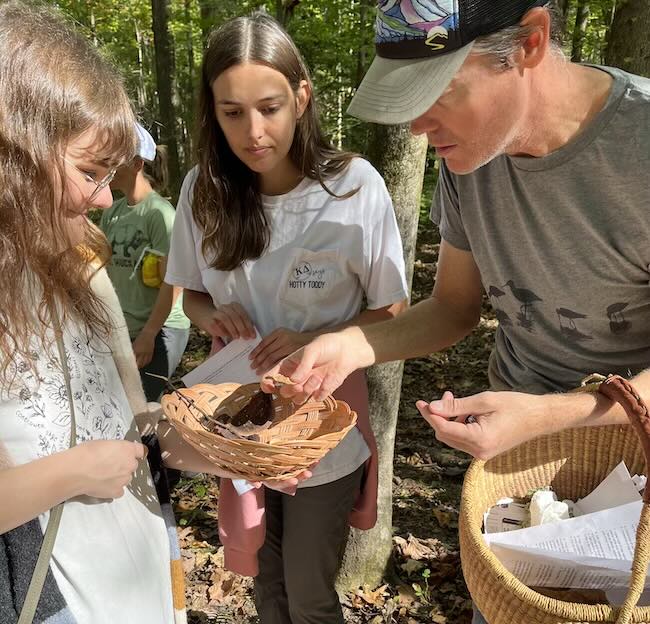Symbiosis and Species Interactions
Discover how organisms belonging to different species interact.
- Home
- Departmental Directory
- Liberal Arts
- Department of Biology
- Faculty, Staff, & Research
- Symbiosis and Species Interactions

Distinguished Faculty Shaping Symbiosis and Species Interactions Research
Departmental research in the area of symbioses and species interactions focuses on how organisms belonging to different species interact. These interactions can be tight symbioses such as mutualism or parasitism, or looser interactions in the broader sense of community ecology.
Faculty Members Who Specialize in Symbiosis and Species Interations Research | ||
|---|---|---|
| Faculty Member | Ph.D. Degree | Research Interests |
| Stephen Brewer | Louisiana State University-Baton Rouge | fire ecology, plant ecology, invasive species |
| Richard Buchholz | University of Florida | animal behavior, host-parasite coevolution |
| Sixue Chen | East China Normal University | plant disease triangle – “tug of war” between plant cells and bacterial pathogens under climate change |
| Tamar Goulet | SUNY at Buffalo | symbiosis and host-symbiont genotypic combinations, marine ecology, coral reefs, coral-algal physiology |
| Jason Hoeksema | University of California-Davis | ecological and evolution of mycorrhizal symbiosis, common mycorrhizal networks, shorebird foraging ecology in managed wetlands |
| Erik Hom | University of California-San Francisco | synthetic ecology, fungal-algal interactions, evolution of symbiosis and microbial consortia, waste valorization |
| Colin Jackson | The University of Alabama | microbial ecology and diversity, microbiome studies |
| Christopher Leary | University of Oklahoma-Norman Campus | endocrine and neural systems underlying animal communication and behavior |
| Michel Ohmer | University of Queensland | amphibian ecophysiology, disease ecology, host-pathogen interactions, thermal biology, amphibian ecology and conservation |
| University of Hawaii at Manoa | microbial ecology of sustainable agriculture for Earth, Moon, Mars; sustainable systems, and role of quorum sensing in microbial interactions. | |
| Indiana University-Bloomington | evolution of species interactions; experimental evolution with microbes; eco-evolutionary modelling | |
Meet the Faculty
John Brewer
- Professor of Biology
Richard Buchholz
- Professor of Biology and Director of the Center for Biodiversity and Conservation Research
Sixue Chen
- Chair and Professor of Biology
Tamar Goulet
- Professor of Biology
Jason Hoeksema
- Professor of Biology, Associate Chair and Graduate Program Coordinator
Erik Hom
- Associate Professor of Biology
Colin Jackson
- Professor of Biology
Christopher Leary
- Associate Professor of Biology
Michel Ohmer
- Assistant Professor of Biology
Becks Prescott
- Assistant Professor of Biology
Peter Zee
- Associate Professor of Biology
Research and Grants

Investigating Plant Fungi
Dr. Jason Hoeksema’s current research is supported by a grant from the DOE entitled “How do plant-associated fungi mediate vegetation and process shifts in response to interactive global change factors in P-limited dry forest-grassland systems?” The project utilizes EucFACE, a free-air CO2 enrichment (FACE) experiment in southeastern Australia, to investigate the role that mycorrhizal fungi and other soil microbes may play in mediating vegetation responses to global change factors, including elevated atmospheric CO2 and drought.

Studying Sloth Algae
Vedanth Buddala, (BA in Biological Science ’24)
A sloth's fur has green algae/cyanobacteria that is not visible to the naked eye. They are hypothesized to have a crucial role in maintaining the balance of an ecosystem through their movement in their surroundings. Using sloths in zoos to assess microbial diversity and growth, Mr. Buddala worked with Dr. Hom to expand our understanding of sloths, their evolutionary journey, and their unique capacity to support vital ecosystems within their fur.

Mapping Pine Invasion
Hailey Long (BS in Biological Science; BA in Psychology ’23)
Pines are highly invasive trees that are commonly used in pine plantations throughout the Southern Hemisphere. However, the survival and subsequent invasion of pines in exotic environments are dependent on the obligate symbiosis between ectomycorrhizal (ECM) fungi and pines. Ms. Long and her mentor, Dr. Hoeksema, conducted several experiments about how ECM fungi vary in host specificity and compatibility from pine-specialist species.
Become a Biologist
UG
Use scientific methods to understand and predict natural phenomena in the world around us.
- Oxford
UG
Engage in the scientific study of living systems and all their complexities.
- Oxford
GRAD
Prepare yourself for a career teaching biology or participating in diverse fields of biological research.
- Oxford
GRAD
Learn to apply the principles of biology, advanced analytical techniques, and experimental methods to conduct groundbreaking research.
- Oxford
